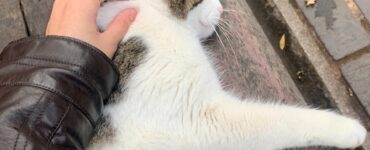From ferocious lions in the wild to your pet tabby, cats possess silent and powerful purpose in everything they do. Cats are territorial creatures, managing to lay claim to diverse domains, which they watch over intently.
Cat Marking
Marking is normal feline behavior and is considered an important part of what is known as nonverbal communication between cats. Marking helps to establish and define boundaries and reassures the cat that the area is familiar. It may also send a signal to other cats that they are ready to mate.
Marking a territory involves the spraying of urine and pheromonesfrome glands strategically located on a cat’s body. These glands are located in the face, around the tail and in the footpads. Researchers have identified nearly 20 different substances that act as chemical markers (or pheromones) in cats.
You’ve seen cats rub their faces or cheeks against objects. This is an instinctual behavior that releases facial pheromones, communicating that the area is familiar and safe. The presence of facial pheromones, even in synthetic form, has been shown to have a calming effect on cats.
Cat Spraying
Urine spraying isanother common form of territorial marking and is often stimulated by olfactory or even visual cues that are new to your cat’s surroundings. Seeing or smelling a strange cat outdoors, new clothing or furniture, a new pet or a visitor in the house could all be good reason for your cat to begin spraying in an attempt to define boundaries and confirm his hierarchy in the social order.
Inappropriate Elimination
If your cat begins urinating outside the litter box, it could be a sign that there is something wrong with your cat or your litter box. You should not confuse improper elimination with spraying, but you should deal with it. Be sure to take your cat to the vet first to rule out physical problems such as diabetes or feline lower urinary tract disease (FLUTD).
It could simply mean that you’re not cleaning the litter box thoroughly enough or that the cat’s food and water sit too close to the litter box. By nature, cats are very clean and tend to be particular about where they deposit their waste. Make sure you are doing all you can to make their litter box a place they want to visit.
Which is Which?
It’s important to make the distinction between inappropriate elimination and spraying. Cats squat down to urinate. When they want to establish a territory and are spraying, they will most often mark vertical surfaces, such as sofas, walls and cabinets. They will stand with their legs straight, tail stiff and vertical, and back up to their intended target before they begin spraying.
There are facial pheromone spray products on the market that can sometimes curb this behavior. The facial pheromones are known to reduce urine marking when applied to an area that has been marked.
Urine Spraying in the Mating Season
Most often when a cat sprays, it’s sexual. During mating season tomcats spray in order to attract a mate and to establish dominance in their domain. Female cats will sometimes spray to communicate their availability.
How to Clean Urine Spray
Loned Haired CalicoIt is important to not use an ammonia-based product to remove the cat’s spray. Because there is a large amount of ammonia in urine, the smell of the product will lead your cat to think that another cat has sprayed in his territory and will actually make the problem worse, as your cat will likely re-spray.
Often it’s difficult to find the exact location of the spray. In order to see where your cat has sprayed, invest in a black or florescent light, which will show you the sprayed areas. Once you have found the areas, you can use a cleaning product to help remove the stains. Check at your vet’s office or at your local pet store to see what types of products are available.
You can also try homemade concoctions to clean the areas. Some cat owners swear that simply rubbing stains with white vinegar will remove discolorations as well as odors.
You can also try this homemade spray, which actually comes from dog owners who have used it to bathe their four-legged friends after skunk assaults. The spray’s easy to make and works well. Simply mix together the following:
- 15 ounces hydrogen peroxide
- two squirts liquid soap
- two tablespoons baking soda.
- Just apply this remedy to the offending area and rinse away with warm water.
- Preventing Cat Spraying
If spraying in a recurring problem, owners should have their cats checked by their veterinarian, who can determine if there is a medical reason for the spraying. If medical troubles are ruled out, try the following:
If possible, place litter boxes where the cat has been spraying.
If you can’t put a litter box in the soiled area, place food where the cat has sprayed. Cats typically don’t like urinating where they eat.
Always maintain a clean litter box. By nature, cats are clean and will refuse to use a dirty litter box.






